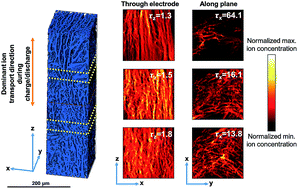Low-tortuosity and graded lithium ion battery cathodes by ice templating†
Abstract
Preserving high energy densities of batteries at fast charge and discharge rates at the cell-stack level is a critical challenge for applications such as electric vehicles. Current manufacturing methods usually produce lithium (Li) ion battery electrodes <100 μm thin with unavoidable tortuous internal porosity that reduces energy densities at fast rates. Here, we use ice templating to manufacture ultra-thick (900 μm) LiFePO4-based cathodes containing fast ion transport pathways and a pore structure gradient through the electrode thickness that promote high energy densities at fast rates. The electrodes exhibit 94 mA h g−1 at an ultra-high current density of 15 mA cm−2 (67% higher gravimetric energy density at the cell-stack level including inactive components) compared with 47 mA h g−1 for conventional electrodes containing random structures and the same materials. X-ray computed tomography and modeling are used to quantify the electrode structure within different sub-domains and along orthogonal directions, which directly rationalizes the excellent dynamic performance. The electrode microstructure design, manufacturing method and characterization tools will be of use for other energy storage and conversion devices that rely on fast directional mass transport.



 Please wait while we load your content...
Please wait while we load your content...